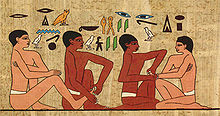Pedicure: Difference between revisions
No edit summary |
|||
| Line 31: | Line 31: | ||
*Polish thinner |
*Polish thinner |
||
*Polish remover |
*Polish remover |
||
*Computer |
|||
*Tree |
|||
==See also== |
==See also== |
||
Revision as of 14:47, 13 January 2010
This article needs additional citations for verification. (March 2008) |

A pedicure is a way to improve the appearance of the feet and their nails. It provides a similar service to a manicure. The word pedicure comes from the Latin words pedis, which means of the ankle, and cura, which means care. It also means the care of the feet and toenails. A pedicure can help prevent nail diseases and nail disorders. Pedicures are not just limited to nails; usually dead skin cells on the bottom of feet are rubbed off using a rough stone called a pumice stone. Additionally, leg care below the knee became a common and now expected service included in pedicures. Leg care includes a depilatory via either shaving or waxing followed by granular exfoliation, moisturizing creams, and a brief leg massage. Any persons at risk for blood clots should forgo leg massage.
Tools and Nail cosmetics
- Tools
- Acetone
- Cotton balls
- Cuticle cream
- Cuticle pusher or Cuticle nipper
- Foot bath
- Lotion
- Nail file
- Nail polish
- Orangewood sticks
- Toenail clippers
- Towels
- Razor or wax strips
- Nail cosmetics
- Base coat
- Cuticle creams
- Cuticle oil
- Cuticle remover
- Dry nail polish
- Liquid nail polish
- Nail bleach
- Nail conditioner
- Nail dryer
- Polish thinner
- Polish remover
- Computer
- Tree
See also
External links
- Pedicure Soothes and Tingles, Leaving Manliness Intact, New York Times, April 2006
- Pedicure etiquette, safety gain a toehold in sandal season, The Grand Rapids Press, June 2008
- Preventing Pedicure Foot Spa Infections, The United States Environmental Protection Agency
